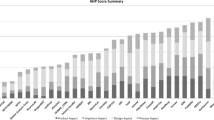Abstract
Many years of effort have been expended by experienced practitioners and academic experts in developing software engineering standards. Organizations should see it as a positive advantage—rather than as a costly negative necessity—when they are required to develop software to a recognized standard. A genuine, constructive program of measures to ensure compliance with an objective standard will achieve development process improvements that would otherwise be difficult to motivate and bring to fruition. Drawing on the author's experience in software development for the Space and Civil Aviation industries, this paper provides an overview and comparison of a number of the available software engineering standards. It goes on to describe implications and benefits that flow from these standards. Suggestions are made for effective practical application of the standards, both at individual project and at organization level.
Similar content being viewed by others
References
Chu-Carroll, M. C. and Sprenkle, S. 2000. Coven: Brewing better collaboration through software conguration management, Software Engineering Notes, 25(6): 88-97.
ESA PSS-05-0. 1991. ESA Software Engineering Standards. Issue 2. European Space Agency (ESA).
FAA JobAid. 1998. Conducting Software Project Reviews Prior to Certification. Federal Aviation Authority (FAA).
FDA. 1998. Guidance for FDA Reviewers and Industry. Guidance for the Content of Pre-market Submissions for Software Contained in Medical Devices. Version 1. U. S. Department of health and human services, Food and Drink Administration (FDA), Center for devices and radiological health (CDRH), Office of device evaluation.
Hayhurst, K. J., Holloway, C. M., Dorsey, C. A., Knight, J. C., Leveson, N. G., McCormick, G. F., and Yang, J. C. 1998. Streamlining Software Aspects of Certi cation: Technical Team Report on the First Industry Workshop, NASA/TM-1998-207648.
IEC 61508-3. 1998. Functional Safety of Electrical/Electronic/Programmable Electronic Safety-Related Systems-Part 3: Software Requirements. First edition. International Electrotechnical Commission (IEC).
ISO/IEC TR 15504-1. 1998/1999. Information Technology—Software Process Assessment (Parts 1 to 9), International Standards Organization (ISO)/International Electrotechnical Commission (IEC).
ISO 9001. 1994. Quality System—Model for Quality Assurance in Design/Development, Production, Installation, and Servicing, International Standards Organization (ISO).
Jacobson, I., Christerson, M., Jonsson, P., and Övergaard, G. 1992. Object-Oriented Software Engineering. A Use Case Driven Approach, Addison-Wesley.
Leveson, N. G. 1995. Safeware, System Safety and Computers, Addison-Wesley.
Martin, J-P. 1992. Qualité du Logiciel et Système Qualité, l 'Industrialisation par la Certification, Paris, Masson.
McGibbon, T. 1999. A business case for software process improvement revised-measuring return on investment from software engineering and management, Air Force Research Laboratory contract no. SP0700-98-4000, http: //dacs.dtic.mil/techs/roispi2, Data & Analysis Center for Software (DACS), ITT Industries, Advanced Engineering and Sciences Division, 775 Daedalian Drive, Rome, NY 13441-4909.
MIL-STD-498. 1994. Military standard: Software development and documentation, AMSC NO. N7069, US Department of Defense.
Paulk, M. C., Weber, C. V., Curtis, B., and Chrissis, M. B. 1995. The Capability Maturity Model: Guidelines for Improvement of the Software Process, Addison-Wesley.
Ropponen, J. and Lyytinen, K. 2000. Components of software development risk: How to address them? A project manager survey. IEEE Trans. on Software Engineering 26(2): 98-112.
RTCA/DO-178B. 1992. Software Considerations in Airborne Systems and Equipment Certification, Washington, RTCA Inc.
Slaughter, S. A., Harter, D. E., and Krishnan, M. S. 1998. Evaluating the cost of software quality. Communications of the ACM 41(8): 67-73.
van Genuchten, M., van Dijk, C., Scholten, H., and Vogel, D. 2001. Using group support systems for software inspections. IEEE Software, pp. 60-65.
Wichmann, B. 1999. Digest of discussion on IEC 61508. http: ///www.cs.york.ac.uk/hise/sclist/ IEC61508.html.
Author information
Authors and Affiliations
Rights and permissions
About this article
Cite this article
Tuohey, W.G. Benefits and Effective Application of Software Engineering Standards. Software Quality Journal 10, 47–68 (2002). https://doi.org/10.1023/A:1015772816632
Issue Date:
DOI: https://doi.org/10.1023/A:1015772816632




